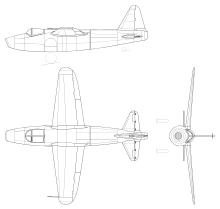Heinkel He 178
The Heinkel He 178 was the world's first aircraft to fly under turbojet power, and the first practical jet aircraft. It was a private venture by the German Heinkel company in accordance with director Ernst Heinkel's emphasis on developing technology for high-speed flight. It first flew on 27 August 1939, piloted by Erich Warsitz. This flight had been preceded by a short hop three days earlier.
| He 178 | |
|---|---|
| He 178 replica at Rostock-Laage Airport | |
| Role | Experimental prototype/Pioneer aircraft |
| Manufacturer | Heinkel |
| First flight | 27 August 1939 |

Development
In 1936, a young engineer named Hans von Ohain had taken out a patent on using the exhaust from a gas turbine as a means of propulsion.
He presented his idea to Ernst Heinkel, who agreed to help develop the concept. Von Ohain successfully demonstrated his first engine, the Heinkel HeS 1 in 1937, and plans were quickly made to test a similar engine in an aircraft. The He 178 was designed around von Ohain's third engine design, the HeS 3, which burned diesel fuel. The result was a small aircraft with a metal fuselage of conventional configuration and construction. The jet intake was in the nose, and the aircraft was fitted with tailwheel undercarriage. The main landing gear was intended to be retractable, but remained fixed in "down" position throughout the flight trials.
The high-mounted wooden wings had the characteristic Günter brothers elliptical trailing edge. Photos showing a "straight wing" (straight-line-taper in the wing planform, for both the leading and trailing edges) were of the second prototype He 178 V2, which never flew under power.
The aircraft made its maiden flight on 27 August 1939, only days before Germany invaded Poland.[1] The test pilot was Erich Warsitz, who had also flown the world's first rocket powered airplane, the Heinkel He 176, on its maiden flight in June 1939.
Heinkel had developed the turbojet engine and the testbed aircraft, the Heinkel He 178 V1, in great secrecy. They were kept secret even from the German air force, and on 1 November 1939, after the German victory in Poland, Heinkel arranged a demonstration of the jet for officials, which Hermann Goering, commander in chief of the Luftwaffe, did not attend. Ernst Udet and Erhard Milch, Minister of Aircraft Production and Supply watched the aircraft perform, but were unimpressed.[2] While a technical success, speeds were limited to 598 kilometres per hour (372 mph) even when fitted with more powerful HeS 6 1,300lb thrust engines[3] and combat endurance was only 10 minutes.
Undeterred, Heinkel decided to embark on the development of a twin-engine jet fighter, the He 280 as a private venture using what had been learned from the He 178 prototype.
The He 178 V1 airframe was placed on display at the Berlin Aviation Museum, where it was destroyed in an air raid in 1943.[4]
Significance
Ernst Heinkel was disappointed by the lack of official interest in his private-venture jet. In his autobiography, he attributes this to the failure of the leaders of the Reichsluftfahrtministerium to understand the advantages of jet propulsion and what breakthrough the He 178 represented.[5] In fact, the Reich Air Ministry was already developing its own jets, a fact unknown to Heinkel.[6]
Specifications


Data from
General characteristics
- Crew: 1
- Length: 7.48 m (24 ft 6 in)
- Wingspan: 7.2 m (23 ft 7 in)
- Height: 2.1 m (6 ft 11 in)
- Wing area: 9.1 m2 (98 sq ft)
- Airfoil: root: Günter symmetrical 11% ; tip: Günter symmetrical 7%[7]
- Empty weight: 1,620 kg (3,571 lb)
- Max takeoff weight: 1,998 kg (4,405 lb)
- Powerplant: 1 × Heinkel HeS 3 turbojet engine, 4.41 kN (992 lbf) thrust
Performance
- Maximum speed: 598 km/h (372 mph, 323 kn)
- Range: 200 km (120 mi, 110 nmi)
See also
Aircraft of comparable role, configuration and era
Related lists
References
- Koehler 1999, p. 173.
- Koehler 1999, pp. 174–5.
- Rickard, J (27 November 2009). "Heinkel He 178". Military History Encyclopedia on the Web. Retrieved 22 March 2016.
- Smith & Kay 1972, p. 292.
- Thorwald, Jürgen, ed. (1953), Ernst Heinkel: Stuermisches Leben (in German), Stuttgart: Mundus, DNB 451925130.
- Christopher, John. The Race for Hitler's X-Planes (The Mill, Gloucestershire: History Press, 2013), p.59.
- Lednicer, David. "The Incomplete Guide to Airfoil Usage". m-selig.ae.illinois.edu. Retrieved 16 April 2019.
Bibliography
- Koehler, H Dieter (1999), Ernst Heinkel – Pionier der Schnellflugzeuge, Bonn: Bernard & Graefe, ISBN 978-3-7637-6116-6.
- Smith, JR; Kay, Antony L (1972), German Aircraft of the Second World War, London: Putnam, ISBN 978-0-85177-836-5.
- Warsitz, Lutz (2009), The First Jet Pilot – The Story of German Test Pilot Erich Warsitz, England: Pen and Sword, ISBN 978-1-84415-818-8.
External links
| Wikimedia Commons has media related to Heinkel He 178. |
- Erich Warsitz (official website), including rare videos of the Heinkel He 178 and audio commentaries.